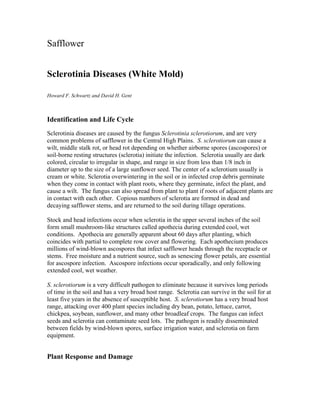
Sclerotinia diseaseswhitemold safflower
- 1. Safflower Sclerotinia Diseases (White Mold) Howard F. Schwartz and David H. Gent Identification and Life Cycle Sclerotinia diseases are caused by the fungus Sclerotinia sclerotiorum, and are very common problems of safflower in the Central High Plains. S. sclerotiorum can cause a wilt, middle stalk rot, or head rot depending on whether airborne spores (ascospores) or soil-borne resting structures (sclerotia) initiate the infection. Sclerotia usually are dark colored, circular to irregular in shape, and range in size from less than 1/8 inch in diameter up to the size of a large sunflower seed. The center of a sclerotium usually is cream or white. Sclerotia overwintering in the soil or in infected crop debris germinate when they come in contact with plant roots, where they germinate, infect the plant, and cause a wilt. The fungus can also spread from plant to plant if roots of adjacent plants are in contact with each other. Copious numbers of sclerotia are formed in dead and decaying safflower stems, and are returned to the soil during tillage operations. Stock and head infections occur when sclerotia in the upper several inches of the soil form small mushroom-like structures called apothecia during extended cool, wet conditions. Apothecia are generally apparent about 60 days after planting, which coincides with partial to complete row cover and flowering. Each apothecium produces millions of wind-blown ascospores that infect safflower heads through the receptacle or stems. Free moisture and a nutrient source, such as senescing flower petals, are essential for ascospore infection. Ascospore infections occur sporadically, and only following extended cool, wet weather. S. sclerotiorum is a very difficult pathogen to eliminate because it survives long periods of time in the soil and has a very broad host range. Sclerotia can survive in the soil for at least five years in the absence of susceptible host. S. sclerotiorum has a very broad host range, attacking over 400 plant species including dry bean, potato, lettuce, carrot, chickpea, soybean, sunflower, and many other broadleaf crops. The fungus can infect seeds and sclerotia can contaminate seed lots. The pathogen is readily disseminated between fields by wind-blown spores, surface irrigation water, and sclerotia on farm equipment. Plant Response and Damage
- 2. Disease symptoms vary depending on whether ascospores or sclerotia initiate an infection. Stem infections by sclerotia first appear just after flowering and are accompanied by a soft, watery rot of basal stems. These lesions enlarge into a watery, rotten mass of tissue that is covered by a white moldy growth. Dark, irregularly-shaped sclerotia are often found in and around infected stems. Infection of stems and branches will cause affected plant parts to wilt and later die, taking on a bleached and dried appearance. Middle stalk rot infection symptoms usually appear near or after flowering in the middle to upper-middle portion of stalks. A brownish-gray soft, water-soaked lesion quickly enlarges to girdle the entire stalk. The stalk usually falls over at the infection point, and tissues above the canker wilt, die, and become bleached in appearance. Head infections first appear as small, water-soaked or bleached spots on receptacles. The fungus continues to grow throughout the head, eventually decaying the entire receptacle and leaving only a bleached, shredded skeleton interspersed with large sclerotia. Spread and development of white mold is greatly influenced by the prevailing weather conditions and certain agronomic practices. The disease may cause serious yield losses during wet, cool periods near the end of the growing season. Management Approaches Biological Control Application and incorporation of the beneficial fungus Coniothyrium minitans strain CON/M/91-08 (formulated as the commercial product Intercept WG) in the fall before spring planting can reduce Sclerotinia. Cultural Control Plant only certified seed free of sclerotia and infested seed. If possible, avoid planting in fields with a history of white mold in other crops such as dry bean. Practice a three- to five-year or longer crop rotation to non-hosts such as corn, small grains, millet, or sorghum. Many weeds can be infected by S. sclerotiorum, so thorough weed control is essential to maximize the benefits of crop rotation. Plant less-susceptible or resistant varieties with open architecture, if available. Promote rapid drying of the soil and foliage by reducing plant population, increasing row spacing, and orientating rows parallel to the prevailing wind direction. Carefully time irrigations to allow the upper two inches of the soil to fully dry between irrigations; and avoid reuse of irrigation tail water from fields where white mold is or has been present. Avoid excessive irrigation and nitrogen fertilization.
- 3. Chemical Control Fungicides are most effective when used in combination with as many cultural control strategies as possible. Product List for Sclerotinia Diseases (White Mold): Pesticide Product per Acre Application Frequency (days) Remarks Neem Trilogy 2 pt 7-14 days Maximum of 2 gallons; 0 day PHI The information herein is supplied with the understanding that no discrimination is intended and that listing of commercial products, necessary to this guide, implies no endorsement by the authors or the Extension Services of Nebraska, Colorado, Wyoming or Montana. Criticism of products or equipment not listed is neither implied nor intended. Due to constantly changing labels, laws and regulations, the Extension Services can assume no liability for the suggested use of chemicals contained herein. Pesticides must be applied legally complying with all label directions and precautions on the pesticide container and any supplemental labeling and rules of state and federal pesticide regulatory agencies. State rules and regulations and special pesticide use allowances may vary from state to state: contact your State Department of Agriculture for the rules, regulations and allowances applicable in your state and locality. Categories: Safflower, Disease, Sclerotinia Diseases, White Mold Date: 3/3/2005
